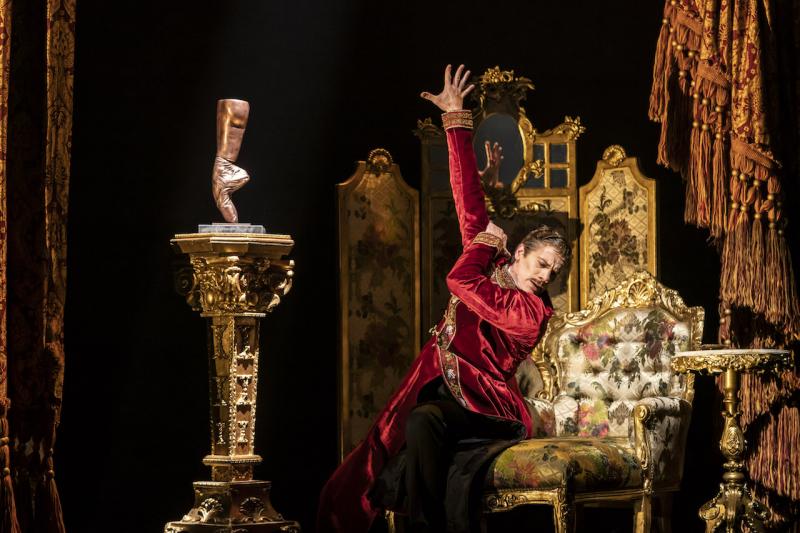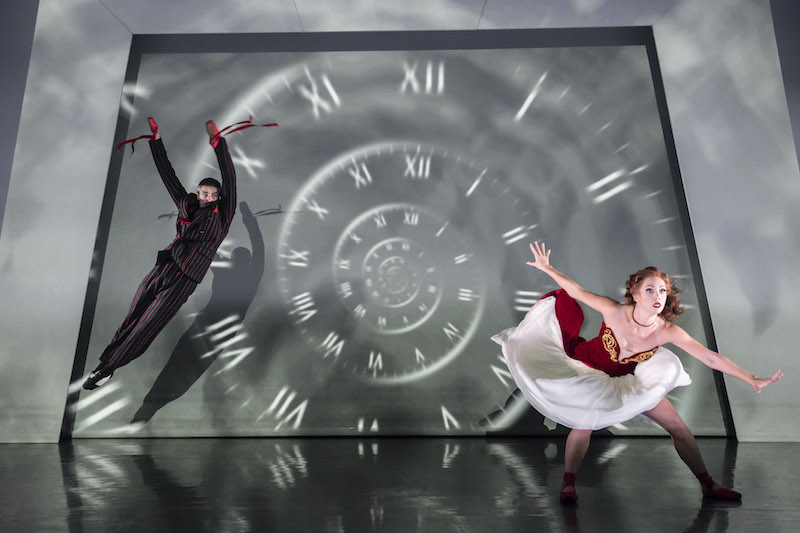The Red Shoes, Sadler's Wells review - the ultimate stage movie | reviews, news & interviews
The Red Shoes, Sadler's Wells review - the ultimate stage movie
The Red Shoes, Sadler's Wells review - the ultimate stage movie
Matthew Bourne's love letter to the cinema returns, in even sharper focus

Matthew Bourne’s tally of hits is such that many of his dance-drama interpretations of old ballets and films were labelled “classic” as soon as they appeared. Yet The Red Shoes, Bourne’s 2016 tribute to the 1948 film, is arguably the one that most rewards repeat viewings. Thickly layered with entertaining detail, you can see it again and again and still find new things to love.
It’s also unique in adding more dance than the original contained. Michael Powell and Emeric Pressburger’s film follows the rise of a talented young British dancer, Vicky Page, as she joins a foreign ballet troupe (loosely based on the Ballets Russes de Monte Carlo which operated in the 1930s and '40s) then finds herself torn between love and art, with tragic results. For a movie about dance, there is an awful lot of talking. Bourne forgoes dialogue, channeling the narrative into dazzlingly fluent movement. And if there were some small areas of fuzziness in the storytelling first time round, these have been dealt with. This is a masterclass in showing, not telling.
 Lez Brotherston’s hyper-mobile set design is key, ushering us from backstage to front-of-stage, from Cote d’Azur to East End music hall. By means of an ingenious swivelling proscenium arch, a single scene can flip between seedy digs in post-war London and a gilded suite in Monte Carlo, or switch the audience’s point of view. One second we’re watching the dancers in a show-within-the-show, the next the proscenium has swung through 180 degrees and we’re seeing the dancers’ backs and the rapt faces of a fictional front row they’re playing to. The notion of watching performers watch performers becomes a fascinating sub-theme.
Lez Brotherston’s hyper-mobile set design is key, ushering us from backstage to front-of-stage, from Cote d’Azur to East End music hall. By means of an ingenious swivelling proscenium arch, a single scene can flip between seedy digs in post-war London and a gilded suite in Monte Carlo, or switch the audience’s point of view. One second we’re watching the dancers in a show-within-the-show, the next the proscenium has swung through 180 degrees and we’re seeing the dancers’ backs and the rapt faces of a fictional front row they’re playing to. The notion of watching performers watch performers becomes a fascinating sub-theme.
The other potent narrative force is musical – Terry Davies’s orchestrations of early movie scores by Bernard Herrmann, played live from the pit. The selections are obscure, pre-Vertigo, pre-Hitchcock even, but the harmonic tug of the familiar later film music is there. And Bourne puts Herrmann’s work to some surprising uses – a bored pavan for posh patrons at a Covent Garden fundraiser and pastiches of ballets known to have toured Europe in the 1940s, not to mention the central Red Shoes ballet (pictured above), closely based on the Hans Christian Andersen story about a girl whose devilish dancing slippers lead to her self-destruction.
Using largely non-classical dancers in a story about classical ballet might seem counter-productive, but it’s dramatic clout that countsA hallmark of Bourne’s best work is its equal appeal to theatre newcomers and cognoscenti who, if unable to identify every one of his arcane historical references as they appear, can later amuse themselves on YouTube tracking them down. Sure enough, at the seedy London music hall where Vicky finds work as a dancer, the wacky comedy double-act turns out to be the once-famous "Sand Dance" of 1934, in which two skinny Englishmen dressed as comedy arabs do a silly dance against a backdrop of the pyramids. It’s horribly funny if certainly racist, though you could argue that it’s the puny Brits who come off worst. Another of Bourne’s traits is that he’s not afraid to sail close to the wind. In his comic pastiches of old ballets his mockery of antiquated performance manners, while raising a laugh, can sometimes seem like biting the hand that feeds.
As always, the performances are impeccable. Though Bourne’s decision to use largely non-classical dancers in a story about classical ballet might seem counter-productive, it’s dramatic clout that counts here. A major new asset to this revival is Adam Cooper in the role of the Svengali-like impresario Boris Lermontov (pictured, top). Stern and chilly, this patrician character is given little to dance, but the economy and focus of Cooper’s acting dominates the stage and his single outburst is explosive. The indefatiguable Ashley Shaw – more Debbie Reynolds than Moira Shearer – resumes the role of Vicky Page with cheery aplomb. But the most memorable turn on opening night came from Dominic North as her love interest, composer Julian Kraster.
Essentially he’s tweedy and shy, but in one fabulously virtuosic solo he reveals his inner fire. Anyone but Bourne would have been content to present Kraster as a Clark Kent-into-Superman type. But Bourne goes further and attempts to get to the nub of the creative process too. In the space of a few minutes he shows us the inner workings of a composer in full flow: the igniting of the spark, the building of musical ideas, the frustrations and the thrill of it as the symphonic textures come together. As a piece of theatrical daring this scene alone merits the ticket.
rating
Explore topics
Share this article
The future of Arts Journalism
You can stop theartsdesk.com closing!
We urgently need financing to survive. Our fundraising drive has thus far raised £49,000 but we need to reach £100,000 or we will be forced to close. Please contribute here: https://gofund.me/c3f6033d
And if you can forward this information to anyone who might assist, we’d be grateful.

Subscribe to theartsdesk.com
Thank you for continuing to read our work on theartsdesk.com. For unlimited access to every article in its entirety, including our archive of more than 15,000 pieces, we're asking for £5 per month or £40 per year. We feel it's a very good deal, and hope you do too.
To take a subscription now simply click here.
And if you're looking for that extra gift for a friend or family member, why not treat them to a theartsdesk.com gift subscription?
more Dance
 'We are bowled over!' Thank you for your messages of love and support
Much-appreciated words of commendation from readers and the cultural community
'We are bowled over!' Thank you for your messages of love and support
Much-appreciated words of commendation from readers and the cultural community
 R:Evolution, English National Ballet, Sadler's Wells review - a vibrant survey of ballet in four acts
ENB set the bar high with this mixed bill, but they meet its challenges thrillingly
R:Evolution, English National Ballet, Sadler's Wells review - a vibrant survey of ballet in four acts
ENB set the bar high with this mixed bill, but they meet its challenges thrillingly
 Like Water for Chocolate, Royal Ballet review - splendid dancing and sets, but there's too much plot
Christopher Wheeldon's version looks great but is too muddling to connect with fully
Like Water for Chocolate, Royal Ballet review - splendid dancing and sets, but there's too much plot
Christopher Wheeldon's version looks great but is too muddling to connect with fully
 iD-Reloaded, Cirque Éloize, Marlowe Theatre, Canterbury review - attitude, energy and invention
A riotous blend of urban dance music, hip hop and contemporary circus
iD-Reloaded, Cirque Éloize, Marlowe Theatre, Canterbury review - attitude, energy and invention
A riotous blend of urban dance music, hip hop and contemporary circus
 How to be a Dancer in 72,000 Easy Lessons, Teaċ Daṁsa review - a riveting account of a life in dance
Michael Keegan-Dolan's unique hybrid of physical theatre and comic monologue
How to be a Dancer in 72,000 Easy Lessons, Teaċ Daṁsa review - a riveting account of a life in dance
Michael Keegan-Dolan's unique hybrid of physical theatre and comic monologue
 A Single Man, Linbury Theatre review - an anatomy of melancholy, with breaks in the clouds
Ed Watson and Jonathan Goddard are extraordinary in Jonathan Watkins' dance theatre adaptation of Isherwood's novel
A Single Man, Linbury Theatre review - an anatomy of melancholy, with breaks in the clouds
Ed Watson and Jonathan Goddard are extraordinary in Jonathan Watkins' dance theatre adaptation of Isherwood's novel
 Peaky Blinders: The Redemption of Thomas Shelby, Rambert, Sadler's Wells review - exciting dancing, if you can see it
Six TV series reduced to 100 minutes' dance time doesn't quite compute
Peaky Blinders: The Redemption of Thomas Shelby, Rambert, Sadler's Wells review - exciting dancing, if you can see it
Six TV series reduced to 100 minutes' dance time doesn't quite compute
 Giselle, National Ballet of Japan review - return of a classic, refreshed and impeccably danced
First visit by Miyako Yoshida's company leaves you wanting more
Giselle, National Ballet of Japan review - return of a classic, refreshed and impeccably danced
First visit by Miyako Yoshida's company leaves you wanting more
 Quadrophenia, Sadler's Wells review - missed opportunity to give new stage life to a Who classic
The brilliant cast need a tighter score and a stronger narrative
Quadrophenia, Sadler's Wells review - missed opportunity to give new stage life to a Who classic
The brilliant cast need a tighter score and a stronger narrative
 The Midnight Bell, Sadler's Wells review - a first reprise for one of Matthew Bourne's most compelling shows to date
The after-hours lives of the sad and lonely are drawn with compassion, originality and skill
The Midnight Bell, Sadler's Wells review - a first reprise for one of Matthew Bourne's most compelling shows to date
The after-hours lives of the sad and lonely are drawn with compassion, originality and skill
 Ballet to Broadway: Wheeldon Works, Royal Ballet review - the impressive range and reach of Christopher Wheeldon's craft
The title says it: as dancemaker, as creative magnet, the man clearly works his socks off
Ballet to Broadway: Wheeldon Works, Royal Ballet review - the impressive range and reach of Christopher Wheeldon's craft
The title says it: as dancemaker, as creative magnet, the man clearly works his socks off
 The Forsythe Programme, English National Ballet review - brains, beauty and bravura
Once again the veteran choreographer and maverick William Forsythe raises ENB's game
The Forsythe Programme, English National Ballet review - brains, beauty and bravura
Once again the veteran choreographer and maverick William Forsythe raises ENB's game

Add comment